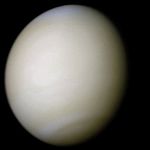- Neith (hypothetical moon)
-
For the Egyptian goddess, see Neith.
Neith is the name given to an object first sighted by Giovanni Cassini, which he believed to be a moon of Venus. It has since been determined that no such moon exists.
In 1672, Giovanni Cassini found a small object close to Venus. He did not take great note of his observation, but, when he saw it again in 1686, he made a formal announcement of a possible moon of Venus.
The object was seen by many other astronomers over a large period of time: by James Short in 1740, by Andreas Mayer in 1759, by Joseph Louis Lagrange in 1761, eighteen observations in 1761, including one in which a small spot was seen following Venus while Venus was in transit across the Sun, eight observations in 1764, and by Christian Horrebow in 1768.
Many astronomers, however, failed to find any moon during their observations of Venus, including William Herschel in 1768.
Cassini originally observed Neith to be one-fourth the diameter of Venus. In 1761, Lagrange announced that Neith's orbital plane was perpendicular to the ecliptic. In 1777, J.H. Lambert estimated its orbital period as eleven days and three hours.
In 1766, the director of the Vienna Observatory speculated that the observations of the moon were optical illusions: the bright image of Venus, he said, was reflected in the eye and back into the telescope, creating a smaller secondary image.
In 1884, Jean-Charles Houzeau, the former director of the Royal Observatory of Brussels suggested that the "moon" was actually a planet which orbited the Sun every 283 days. Such a planet would be in conjunction with Venus every 1080 days, which fit with the recorded observations. Houzeau was also the first to give the object the name Neith, after an Egyptian goddess.
The Belgian Academy of Sciences published a paper in 1887 which studied each reported sighting of Neith. Ultimately, they determined that most of the sightings could be explained by stars which had been in the vicinity of Venus, including Chi Orionis, M Tauri, 71 Orionis, Nu Geminorum and Theta Librae.
See also
- List of hypothetical astronomical objects
- 2002 VE68, a quasi-satellite of Venus
External links
Venus Geography GeneralRegions
Exploration Past and current- Venus spacecraft
- Artificial objects on Venus
- Venera program
- Vega program
- Pioneer Venus
- Magellan
FutureAstronomy Other topics - Cytherean
- In Fiction
- Hesperus
- Mythology
- Phosphorus
- Neith (hypothetical moon)
- Venusians
Categories:- Hypothetical bodies of the Solar System
- Hypothetical moons
- Venus
- Planetary satellites
Wikimedia Foundation. 2010.

